Joy Neal Kidney's Blog, page 13
October 29, 2024
Classroom Questions and Activities: Leora’s Letters – with thanks to Elaine Briggs
Yesterday someone ordered 10 copies of Leora’s Letters from Amazon. Another books club? They might find some of Elaine Briggs’s ideas useful!
Not only has Elaine been an encourager and beta reader for several Leora stories, this retired teacher also came up with classroom topics and activities for Leora’s Letters: The Story of Love and Loss for an Iowa Family During World War II. Here is her list:
Have students choose a brother and complete maps of their various locations stationed during the war. Have students choose a brother and complete a timeline for him, including what training he received and where he was sent for combat.How do the letters let you know farming was very important to the war effort? What was the attitude of the brothers for serving in the war? Give examples. Explain how important letters were to both those who served and those at home. Why do you think censoring of the mail was important? Food was rationed during WW II. Why do you suppose the Wilsons didn’t mention it much? How was life during WW II complicated by having no electricity?Elaine Briggs is also the author of Joe Dew: A Glorious Life, about her father (whose life was amazing), and also Yes! All Can!: Increase Reading Levels in Weeks, Resolve Conflicts and Build Character, Develop Leadership. Elaine enjoys writing things close to her heart, delights in family activities, and lives a on the farm near Milan, Michigan. She volunteers one-on-one tutoring with EBLI and loves that light-bulb moment when a student “gets” reading.
October 24, 2024
An Heirloom with a Mystery: The Stuart Spoon
The Stuart Spoon
 Inheriting her grandmother’s cherished spoon collection was just the beginning for Caroline Barrett. Little did she know, tucked away among the treasures from charming destinations lay a mystery waiting to be unraveled.
Inheriting her grandmother’s cherished spoon collection was just the beginning for Caroline Barrett. Little did she know, tucked away among the treasures from charming destinations lay a mystery waiting to be unraveled.
Twenty-five years after her grandmother’s passing, Caroline stumbles upon a spoon from Stuart, Iowa—a place never mentioned in her grandmother’s tales of adventure. Intrigued and determined to unearth the truth, Caroline embarks on a journey that leads her deep into the heart of her grandmother’s past.
As she delves into the history of the mysterious spoon, Caroline uncovers a romance that transcended time and distance—a love story between her grandmother and a man from the distant shores of Nova Scotia. With each revelation, Caroline is drawn deeper into the enchanting narrative, weaving together the threads of her family’s past and present.
Set against the backdrop of two countries and spanning generations, The Stuart Spoon is a captivating tale of love, loss, and the enduring power of family bonds. Join Caroline as she embarks on a quest to unlock the secrets hidden within her grandmother’s spoon collection and discovers a legacy of love that will forever change her life.
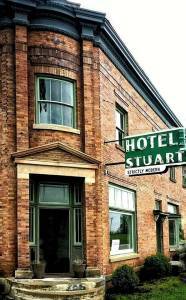 A Joe Kenney photo
A Joe Kenney photoMy Thoughts
The only thing better than an heirloom is one with a story. And this story of a souvenir spoon from the 1920s, passed down to a granddaughter, comes with a mystery! What a delight to follow along with search for clues, with the results at once exhilarating and poignant. Half of the mystery is set in the small town of Stuart, Iowa, right along White Pole Road, where many of my own grandparents’ stories are set, also during the 1920s. Just delightful!
The author has been back to Stuart not long ago to talk about her compelling story.
The Author
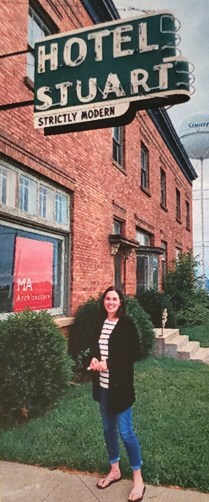 The author at historic Hotel Stuart, along White Pole Road, Stuart, Iowa
The author at historic Hotel Stuart, along White Pole Road, Stuart, IowaCarrie Landgraf is a fresh voice in the world of authors, fueled by a deep passion for storytelling and a love for the written word. Residing in the heart of the Midwest alongside her husband Brian, Carrie finds inspiration in the simple joys of everyday life.
As the proud parent of three married children, Carrie’s world revolves around the bonds of family and the values of faith. Embracing her newest role as a Nonna, she cherishes every moment spent with her beloved granddaughter, finding endless joy in her laughter and innocence.
. . . With a heart as warm as her prose and a spirit as bright as her imagination, Carrie Landgraf invites readers to join her on a journey of love, laughter, and the beauty of life’s simple pleasures.
October 21, 2024
Typing letters home under mosquito netting in a tent in New Guinea
17-Mile Field, Port Moresby, New Guinea
The day of their first mission, October 21, 1943, Dale Wilson wrote home, “We have to clear off a patch of ground and erect our tent or, as some are doing, building a shack out of swiped lumber or lumber acquired by producing a little liquor at the right place–usually at the saw mill. We are figuring on using some shale or gravel as the floor for our tent. Yesterday I cleared off a place on a little knoll which had an area a little larger than the tent on top. The water can run away from it in all directions. I picked the spot after Lt. Stack (Bombardier-Navigator) suggested we build down in a ditch just because it was flat. I dug nice drainage ditches and built up our foundation with clay. It is going to be a good place to live after we get the tent put up and fix ourselves a few little conveniences.”
 Dale Wilson is standing in the back. John Stack is standing, right. Behind is a B-25G Mitchell medium bomber.
Dale Wilson is standing in the back. John Stack is standing, right. Behind is a B-25G Mitchell medium bomber.The same day, the bomber’s navigator, John “Junie” Stack wrote home that they were building a place to live out of what lumber we can buy or steal. . . .If you don’t want to build one and screen it in, you can sleep in a tent and give your blood to the mosquitoes, so Wieland [pilot], Wilson [copilot], Flaczinksi (“Irish”) [I’m not familiar with this name] and myself have started one.”
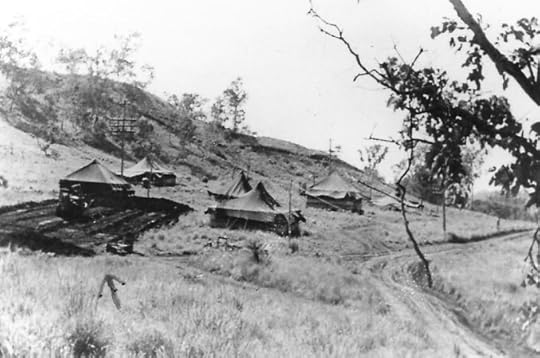 Officers’ tents at 17-Mile Field, Port Moresby, New Guinea. Photo courtesy of Curtis E. Swan.
Officers’ tents at 17-Mile Field, Port Moresby, New Guinea. Photo courtesy of Curtis E. Swan.The next day, Lt. Stack added, “Finished it will be a wooden, screened-in house with a tent for a roof, if you can picture that. Material is awfully hard to get, and right now we’re trying to drive a bargain to get six hundred feet of flooring for four quarts of gin. It should work out, as the Aussies have all the lumber and we have all the liquor. Right now we have the foundation nearly done on the side of a hill. It should be pretty nice when finished. Better anyway than giving you blood to the mosquitoes rather than to the Red Cross!”
Dale mentioned the mosquitoes as well. More about 17-Mile Field. Each man had a canvas cot with a mosquito net.
“Dale, like all of us, lived on a mountainside in a 16’X16’ tent,” veteran Lew Pavel wrote decades later. Four to six officers lived each tent, which had a dirt floor and one small light bulb. A light bulb! Each man had a canvas cot with a mosquito net.
Dale Wilson also told about their primitive living primitive. They cleared off a knoll a little larger than the tent, dug drainage ditches so water could run off in all directions, and built up a clay foundation. “The sweat runs off you like water,” he wrote. “I actually sweat out more liquid than I can drink. We even urinate very little. I am thirsty all the time and drink water continually.”
Stack mentioned a typewriter in one letter. “The typewriter is needed, so will sign off for now.” Typewriters during the 1940s were not light weight. It’s hard to imagine, but Dale Wilson also typed letters–sitting on a cot in his tent and under mosquito netting.

This crew was lost November 27, 1943, hit by AA fire, just off Boram/Wewak, New Guinea. It was Dale Wilson’s 13th mission, Junie Stack’s seventh mission, Ted Sharpton’s one and only mission.
Information about John R. Stack is from Reading Between the Lines: Getting to Know Uncle Junie Through the Letters He Left Behind by Mary and Jim Ragsdale. Jim Ragsdale, a reporter for the Saint Paul Pioneer Press and later for the Minneapolis Star Tribune, began the manuscript before his death in 2014. His widow and the niece of Junie Stack later finished the book, which was published only for family. Mary is looking into offering it more widely as an ebook.
See also: Leora’s Letters: The Story of Love and Loss for an Iowa Family During World War II. And What Leora Never Knew: A Granddaughter’s Quest for Answers.
October 19, 2024
What’s Next? What are Your Thoughts?
Seven generations, six with deep roots in one Iowa county, or with strong ties to it, since 1855–from pioneers to the keeper of their stories. Of the six, the author is the only one who never lived among the rolling hills of Guthrie County, Iowa, but it’s where her beloved Grandma Leora was born, where she lived to the age of 97.
The men these women married will make cameo appearances.
What do we inherit from our grandmothers besides mtDNA? Heirlooms? Character? Shadows of the past? The legacy of a small log church in Indiana was nurtured through my motherline and woven into the blessing and mystery of my own inheritance, that of lives lived with faith in the God, family, community, and the hope of heaven.
Remember the days of old, consider the years of many generations. – Deuteronomy 32:7

Yes, I’m working on another book, feeling my way into it. Above, so far, is a back cover copy WIP (work in progress). Is it compelling enough? No title yet. What do you think?
Motherline: A Legacy of Seven Generations
Guthrie County: Motherline Songs, Seven Generations
Meadowlark Songs: Consider the Years of a Motherline
The Legacy of *Rocky Fork: Motherline Musings
*Rocky Fork is a Baptist church from the first generation, before any of them came to Iowa, but perhaps it’s not poignant enough to become a title.
Seven GenerationsAccording to Native American tradition,
the consequences of choices
made by ancestors in one generation
reverberate for seven generations.
Make those decisions with utmost care,
they say, to guarantee good lives
for those who come after.
Seven generations of a motherline,
six lived in Iowa,
five in Guthrie County,
four were oldest daughters,
three lived into their nineties,
two with high school diplomas,
one became the keeper of their stories.
October 17, 2024
Laura Goff gets a Marcel Wave
 “Omaha, Nebr. Mar. 14, 1940
“Omaha, Nebr. Mar. 14, 1940
“Dear Folks, [Laura Goff to Clabe and Leora at Minburn]
“How are you? We are all well and ready for 3 square meals a day. Do you cook in the basement and did the landlord put the sink in the kitchen? [The house at the Minburn farm didn’t have running water in the house.] We had another big snow 6 in. Tues., all day snow, and snowed some yesterday. Bernadine [Jennings Goff’s wife], baby [Ronnie], and Maxine were here Tues. and J.B. [Jennings] came for dinner. Maxine stayed till this eve and she gave me a Marcel yesterday and trimmed my air also, so it looks quite nice today.”
What a sweet connection between Maxine Goff and her grandmother. After their own mother died when they were children, Maxine and Merrill (along with their father Jennings) lived with their grandparents, first at the Victorian house in Guthrie Center, then the house along White Pole Road in Dexter.
After Laura was widowed and they lost the house in Dexter during the Depression, they all moved in with Clarence Goff in Omaha, where Merrill and Maxine attended high school. Then Maxine decided to become a beautician. Her grandmother became her model for practice and for taking the practical tests in Lincoln.
Marcel waves were the rage during the 1920s, but evidently they were still popular years later and beautician needed to know how to do it properly.
October 15, 2024
Questions to Ponder: Leora’s Letters
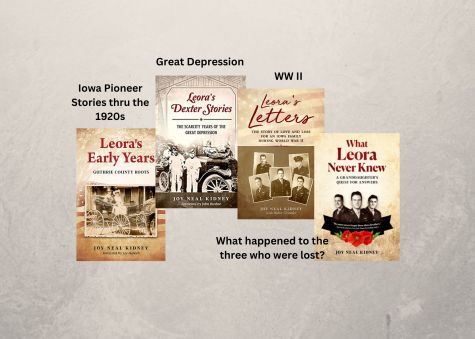
Several book clubs have chosen Leora’s Letters to read and discuss, from Texas to Indianola and Polk City. Thanks to Deni Scar Sobek, the latest was in Oak Ridge, Tennessee. (Her grandmother was Darlene Wilson Scar, twin sister of Dale Wilson.)
The book has these discussion questions at the end to help get a discussion started.
Questions to Ponder
Do you have family members who served in World War II, or at another time in our history? Has anyone recorded their stories? How could you make sure they are? Memorial Day is dedicated to remember Americans lost in wars. If your family has no combat losses, how you make sure to remember them on Memorial Day? How could you help the next generations think about the nation’s great losses? Thousands of graves of young Americans lie in foreign countries which our soldiers helped free from tyranny. They have regular ceremonies to remember and reflect. Because WW II was fought on foreign soil, does that affect your perspective about American losses?What do you think motivated the Wilson brothers to enlist? What motivates people today to join the military?Several family members advised the youngest brother to stay home with their parents. How might that have eventually changed family dynamics from his point of view? What about his parents? What did the Wilson family do to cope with all the uncertainty during the war? For months after the war, the Wilson still had no answers about what had happened to two of their sons. How did they get through those anxious days? What would you have done? Essie Sharpton was a faithful correspondent for Leora through the decades, helping to sustain and encourage her. Has someone in your life come alongside when things have been tough? Have you been able to do the same for someone else?C.S. Lewis said, “I have seen great beauty of spirit in some who were great sufferers.” (The Problem of Pain) Have you know someone with a sweet spirit in spite of physical or emotional pain? What do you think sustains them? There’s something precious about being able to hold and keep a letter, a tangible blessing. People during World War II sometime had to wait for one, heightening the tension families already felt. Do you have any old family letters? Why do you think people keep them for decades?Leora’s Letters is also available as an audiobook, narrated by Paul Berge. You may listen to a sample below the cover.
October 10, 2024
What Happened to Laura Goff’s Long Hair?
As an adult, Laura Goff always wore her long hair pinned up, neatly out of the way for her many chores. I didn’t know here in her early days, just from the old photos.
When I was a child, she lived with my Grandma Leora, who was her oldest daughter. She had short hair then, mostly non-descript. But there are some photos of her with interesting waves and swirls. I finally figured out why, and when, she got her hair cut for the first time.
Laura’s son Jennings married Tessie after he returned from WWI. Their first child was a daughter named Maxine. In 1924, Tessie gave birth to a son. They both came down with mumps and Tessie died when Merrill was just four days old.
Jennings and his youngsters moved in with his parents (Sherd and Laura Goff), although Maxine and Merrill stayed with Tessie’s folks as well. They attended school in Dexter during the 1930s, living with Laura Goff after Sherd’s death in 1930.
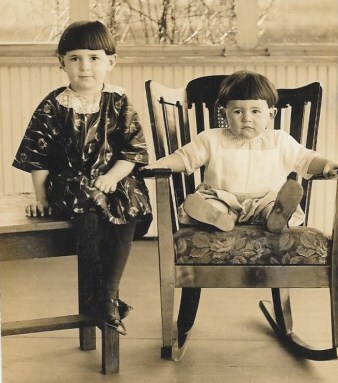
Brothers Jennings and Merl Goff had bought gravel trucks while living at Dexter, using the Goff home as collateral. But as the Depression deepened, they couldn’t keep up with the payments. Their youngest brother, CZ (Clarence Zenas) Goff, had a heating and cooling business in Omaha. He offered them jobs and a place to live, including their mother Laura, also Maxine and Merrill, who were teenagers then.
So Maxine and Merrill attended high school in Omaha. Maxine decided she’d like to go on to beauty school. Was that idea sparked by her Aunt Leora saving a botched haircut by her Grandfather Sherd?
Maxine practiced on her grandmother! I’d guess that she gave Laura her first haircut, and practiced all kinds of styles on her. When it was time for Maxine to take her practical tests, Laura was her model.
 Maxine Goff, Omaha
Maxine Goff, Omaha“Omaha, Oct-12, 1939
“Dear Folks, [Laura to Clabe and Leora at the Minburn farm]
“. . . I am going out to Lincoln [Nebraska] tomorrow to be Maxine’s model. She has been here all week working some every day on my air and face and hands. She says lots of the girls have models old as I am. Merl is taking us in the car. . . Love, Mother”
“Omaha, Nov. 1, 1939
“Dear Folks, [Laura to Clabe and Leora]
“Well Maxine got her certificate today to be a beauty operator, and we are all so glad she passed. Well, I enjoyed the day at Lincoln as a model, could look across the table and see the others doing just that Maxine was doing to my hair. . .
“Have you ever tried carrots and raisins with a little sugar and cream or a little mayonnaise? Run the carrots through chopper. We like them that way. . . . Love, Mother”
Laura Goff was known for squeezing more writing on a postcard than anyone. She certainly didn’t want to waste any of the space, adding kitchen tips at the end if she could work it in.
October 8, 2024
Square Dancing

My folks went to square dances when I was a child. They are for four couples, or eight dancers in total, arranged in a square, with one couple on each side, facing the middle of the square. After you learned how to do an “allemande left,” “do si do,” “promenade,” “right and left grand,” and a lot more calls, the caller could mix them up however he wanted. Dancers had to listen and be quick to react.
Mom made her square dance dress from a crinkled cotton, with silver rickrack and a decorative tape with silver and gold threads. I wish I had a photo of her wearing it. But Dad was a WWII pilot, with hundreds of hours in noisy cockpits. They eventually gave it up because he couldn’t hear the tricky calls to be able to keep up with the rest of their square.

A few square dance lessons were part of Ruth Sellers’ music curriculum when we were in grade school at Dexter.
About the time I was a freshman in high school, late 1950s, small towns held square dances for teens. I made my own dress, pink gingham with decorative tape of pink and silver. Sis Gloria’s (at left) was like it only in blue gingham. We wore plenty of stiff petticoats under the skirts and it looks like we both wore moccasins to dance in.
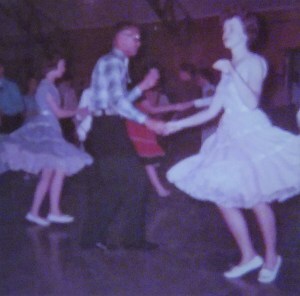 Sis Gloria, Johnny Jones doing an allemande right with me.
Sis Gloria, Johnny Jones doing an allemande right with me. Some of the dances were held in Winterset, some in Menlo, and I remember one at the rural school near the Penn Center church where voting was held.
Some of the dances were held in Winterset, some in Menlo, and I remember one at the rural school near the Penn Center church where voting was held.One of the most fun things we’ve watched are the Farmall Promenade Square Dancing Tractors when they were at the Iowa State Fair one year. The drivers were actual farmers from the tiny town of Nemaha, Iowa.
October 3, 2024
What the Doctor warned Sherd Goff
In addition to moving the family every year or so, Sherd Goff fathered eleven children. By the time his wife gave birth to Willis, her eighth baby in eleven years, she was worn out. The doctor warned Sherd that it would be a good idea to let her get some rest between babies.
From the memoir of their firstborn, Leora: “It was the spring of 1902. Willis was born March 8, 1902. Grandmother and Grandpap Goff were with us the winter of 1901-1902. Grandmother took care of baby Willis until Mamma could, and we had a hired girl for awhile, too. . .”
But by the next spring, Sherd bought a farm in northern Minnesota. “Mamma told Pa that she would move to any State he thought best to make a living, but wouldn’t move to Canada or out of the United States,” Leora wrote. “We almost made it to Canada when we went to Minnesota in 1903. It was 80 miles from the Canadian line.”
“Grandmother and Grandpap Goff were with us. Pa and Grandpap left with a stock car train a week or more before we did. There were two cows, some chickens, and household goods. We stayed at Grandpap Jordan’s a few days and left by train about March 20th. It was nice spring weather in Iowa. We had a wait of a few hours in St. Paul, Minn., and some or all of us [including the eight children] were getting colds, even Grandmother Goff. Mamma was the only one all right when we got to Grand Forks, North Dakota. My father had come to meet us from Key West, Minnesota, a little place 13 miles eat from Grand Forks, and Grandpap Goff came in a bobsled in a blizzard to meet us at Key West. . .”
Two More Sons
While they lived in Minnesota, Perry Goff was born September 15, 1903. So much for the doctor’s warnings. By early 1905, they were all ready to move back to Iowa, where Clarence was born September 4, 1905. Ten births in fifteen years. So much for the doctor’s warnings.
But all the Goff children (except the last one, Virgil, who lived just a year) lived into adulthood. One daughter (Georgia) died in 1922. The rest outlasted their father, Sherd Goff, and lived into their eighties and nineties. In spite of all those births and moves in such a short time, Laura Goff outlived her husband by 32 years.
 Leora Goff Wilson (oldest child of Laura Jordan Goff), JB (Jennings) Goff from Omaha, Laura Jordan Goff (age 89), CZ (Clarence) Goff from Omaha, Wayne Goff from California, Ruby (Goff) Blockley (ten years younger than Leora), Willis Goff from California, Merl Goff from Omaha. Bachelor brothers, Perry and Rolla who lived on the East Coast, were the only living siblings not at the reunion. (Georgia Goff, who is buried in Guthrie Center) had died in 1928.) Guthrie Center, Iowa, 1957. Photo by Gary Blockley
Leora Goff Wilson (oldest child of Laura Jordan Goff), JB (Jennings) Goff from Omaha, Laura Jordan Goff (age 89), CZ (Clarence) Goff from Omaha, Wayne Goff from California, Ruby (Goff) Blockley (ten years younger than Leora), Willis Goff from California, Merl Goff from Omaha. Bachelor brothers, Perry and Rolla who lived on the East Coast, were the only living siblings not at the reunion. (Georgia Goff, who is buried in Guthrie Center) had died in 1928.) Guthrie Center, Iowa, 1957. Photo by Gary Blockley
October 2, 2024
No Chickens, No Sheep, but
 May I use your needlepoint farm on the cover of my new poultry cookbook? she asked.
May I use your needlepoint farm on the cover of my new poultry cookbook? she asked.
This was in 1985. The author, Mitzi Ayala, was a Harvard graduate and ricer grower from California, hostess of “Mitzi’s Country Magazine” TV program, speaker, columnist, and author of several Prairie Farmer cookbooks.
There’s not one chicken in my 1976 needlepoint farm, but her book was published by Wallace-Homestead Book Company, which had Iowa connections. I was credited for the “original needlepoint design.”
I don’t know how the author or publisher learned about the needlework farm back then, but the internet has enabled connections which would be impossible otherwise.
Lamb’s Ears Poem
 I’d forgotten about this until recently being asked by a garden newsletter editor in Texas if she could include one of my poems. She’d planned to feature a plant she’d come across while visiting Mount Vernon, and ran into my poem while googling Lamb’s Ears and wanted to know the backstory.
I’d forgotten about this until recently being asked by a garden newsletter editor in Texas if she could include one of my poems. She’d planned to feature a plant she’d come across while visiting Mount Vernon, and ran into my poem while googling Lamb’s Ears and wanted to know the backstory.
Ivy Summerfield’s delightful Plant of the Month story about Lamb’s Ears is in October 2024 issue of The Root, the Denton County Master Gardener Association publication, pages 7 and 8. (Please click on the link to access the entire handsome issue.)
I also learned a lot about this humble plant. And unexpected connections the internet makes possible.



